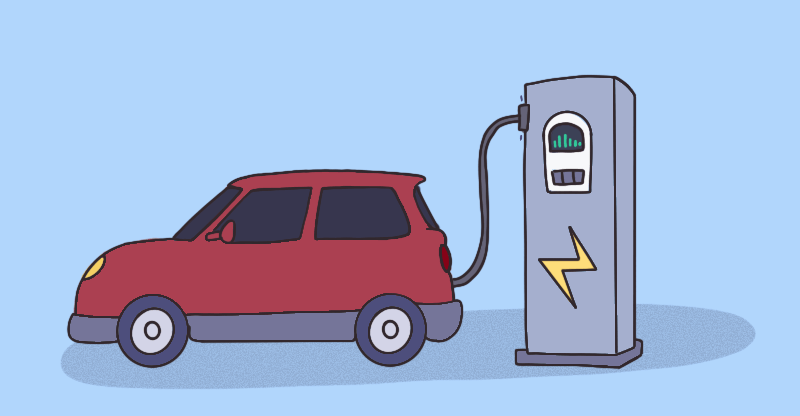All the things to know before you rent an EV on vacation
3 February 2023
Most major rental car companies offer electric vehicles (EV) and traditional gas-powered cars; in some cases, travelers consider their next trip the perfect time to try out an EV. In some locations or seasons, rental cars can be tough to find, making the idea of trying out an EV even more attractive.
At the same time as people are generally growing more curious about EVS, electric vehicle fleets are growing. Hertz is one of the companies that has aggressively ![]() added electric vehicles to its fleets.
added electric vehicles to its fleets.
Renting an EV requires more planning than a traditional vehicle. Electric vehicles not only work differently than traditional vehicles, they also vary significantly from each other. So you’ll need to research before you rent an EV even if you drive one on a routine basis.
Here’s what you need to know before renting an EV on your next trip.

An EV will cost more to rent
An electric vehicle may be gas free, but it’s still not cheap. According to Elliott Confidential reports, however, electric cars cost roughly 20% more to rent, and that’s only the beginning. There are unexpected costs to renting an EV that may shock travelers—even those who regularly drive one at home.
If you’ve rented a gas-powered car in the last decade or so, you know that there are options for filling it up before you turn it in. The same-ish scenario applies to EVs. Some car rental companies require that the EV be returned more than 70% charged, or you’ll be charged a fee. The fee goes up as the rate of charge goes down.
To make things worse, the policies for charging fees vary from company to company, so you’ll have to research those before driving off the rental lot.
Pro tip: Consider charging fees as a supercharged refueling fee because rental companies charge three times as much as the market rate to top off an EV.
Renting an EV takes planning
When renting an EV—especially if it’s your first time driving one—you want to be sure that the rental company representatives can accurately answer any questions about the vehicle.
Where are you planning to drive the vehicle?
Are you planning to go between the hotel and the office, maybe out to dinner, for a quick business trip? Are you planning a city-to-city drive (rental companies don’t yet allow one-way EV trips)? Thinking these plans through will help with the rest of the planning.
What’s the range of the vehicle?
Why is this important? How far you can go on a single charge becomes very important when you consider that recharging the vehicle can take anywhere from an hour to days, depending on the vehicle, the plug, and the charging station.![]() Look up the EV range (sorry, it’s in kilometers, so you’ll need to do some math) of the vehicle you’re renting. If the car rental company can’t tell you which vehicle you’ll get when you rent, this can be tricky.
Look up the EV range (sorry, it’s in kilometers, so you’ll need to do some math) of the vehicle you’re renting. If the car rental company can’t tell you which vehicle you’ll get when you rent, this can be tricky.
Factors like temperature, incline, traffic, speed, and air conditioning or heat can also impact battery usage. Depending on the route, road conditions, and season, you may need to charge less or more.
What type of charger do you need?
Here’s where an EV is similar to traditional gas vehicles: the conduit to fill it (a hose for gas-powered vehicles, a charging cord for EVs) is positioned where you fill up. Like needing to fill up a diesel engine, for example, you’ll need to find a charging station that can fill your vehicle. Essentially, the type of charger you’ll need depends on the vehicle you’re renting.
There are three types of EV charging: Level 1, 2, or 3, and they’re not found equally. Most EVs are compatible with Level 2 chargers, which fully charge the vehicle in 5-7 hours.
Some newer EVs are compatible with Level 3 chargers, which are faster. In some cases, as quick as 30 minutes. Tesla vehicles can also charge on the manufacturer’s Supercharger network if it exists in the area you are traveling.
See the Roadtrippers for ![]() how to find charging stations on a road trip.
how to find charging stations on a road trip.
What’s the charging station infrastructure like?
Booking accommodations with EV charging stations can help. A growing number of hotels and even some campgrounds now offer Level 2 chargers so that you can charge the vehicle overnight.
Tesla cars have an integrated nav system that identifies charging stations along your route, complete with charger type.
A growing number of apps like the following can help you find charging stations if you’re renting a vehicle other than a Tesla:
Please note that while there are free ![]() public charging stations, others charge at a cost. Free charging stations are far less common than those requiring payment.
public charging stations, others charge at a cost. Free charging stations are far less common than those requiring payment.
Expect a learning curve
Don’t set your expectations too high; while progress is being made, electric charging is just not as convenient yet as it could be. If you’re the type of traveler who plans to fill the vehicle just a few miles from the airport, you could be out of luck. Many Tesla supercharger stations have long lines of people waiting to charge.
After loading your luggage in the frunk, spend a little time understanding how the ![]() features and the navigation system work—even those who regularly drive one at home. Some travelers recommend using the lot time to ‘test drive’ the vehicle, especially if it uses regenerative braking, which can initially feel weird.
features and the navigation system work—even those who regularly drive one at home. Some travelers recommend using the lot time to ‘test drive’ the vehicle, especially if it uses regenerative braking, which can initially feel weird.
Some EV owners explain that driving an EV is like driving a giant iPad; there are an overwhelming number of features to learn, including tricky door handles, so plan in extra time.
Related topics
Damian Tysdal is the founder of CoverTrip, and is a licensed agent for travel insurance (MA 1883287). He believes travel insurance should be easier to understand, and started the first travel insurance blog in 2006.
